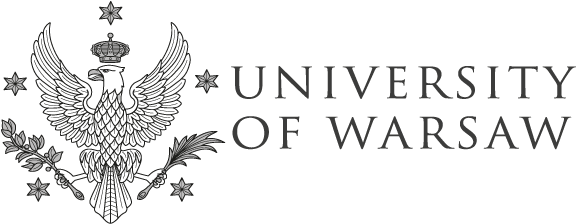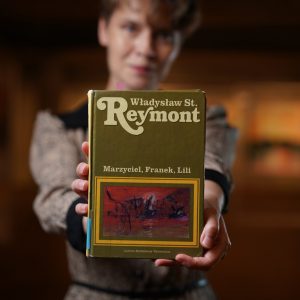“We all know ‘The Peasants’ and ‘The Promised Land,’ but let’s remember that Władysław Reymont learned to observe and think in living language when working on the railway and through acting – which is probably why the novella ‘Lili’ is so interesting to me. As a reader, I can trace Reymont’s lively language in it,” says Dr Eliza Kącka from the Faculty of Polish Studies at the University of Warsaw in the latest episode of the fourth series of ‘Read with the UW’.
Dr Eliza Kącka works at the Institute of Polish Literature at the Faculty of Polish Studies at the University of Warsaw, in the Department of Literature and Culture of the Second Half of the 19th Century.
A writer, literary scholar and critic, she is the author of the prose books: Elizje (2017), Po drugiej stronie siebie (2019), Strefa zgniotu (2022), Wczoraj byłaś zła na zielono (2024), the essay book Idiomy. Eseje (2023) and academic books: Stanisław Brzozowski wobec Cypriana Norwida (2012), Lektura jako spotkanie. Brzozowski – tekst – metoda (2017). She has compiled several selections of poetry (not only the most recent). She is also a columnist and contributor to Tygodnik Powszechny.
An unfulfilled dream
Władysław Stanisław Reymont is one of the most important writers of the Young Poland movement. A prose writer and novelist, he was a representative of realism and naturalism. His most famous work is the four-volume epic novel The Peasants, for which he received the Nobel Prize in Literature in 1924.
Reymont abandoned his education at a fairly early age. He trained as a tailor and worked for the railways. His youth also included a stint in the theatre. Reymont, then still known as Rejment, joined a theatre troupe in search of excitement and a life different from that offered by his hometown.
“Imagine a man who is trying his hand in the theatre, who has no talent, is short-sighted, is completely hopeless at acting, but writes and records aurally – with a keen sociological sense – all the problems of being an actor in Poland at that time,” says Dr Eliza Kącka.
Reymont’s attempt to join the theatre was a time of hardship and disappointment for him. Unfortunately, travelling theatres did not give him either stability or success.
“The humiliation of always being in the background, of not being able to jump centre stage and play the role of a lifetime, somehow deprives and destroys life,” emphasises the researcher, adding: “This acting episode, though short, left a lasting mark on the author’s biography and work.”
Proof of how much this experience influenced Reymont can be found, for example, in his 1899 novella Lili.
Reymont’s language
Reymont’s work depicted the realism of social and moral life, characterised by a deep understanding of the human psyche and a style that reflected spoken language. Dr Eliza Kącka emphasises that it is Lili, Marzyciel and Komediantka that best demonstrate his exceptional ear for language and sensitivity to colloquial speech.
“As a reader, I track Reymont’s lively language, his incredible sense of orality,” says the researcher.
Reymont’s above-average feel for language is evident in his ability to convey lively, spoken language – full of colour, rhythm, emotion and local idioms. His linguistic ear, sensitive to the authentic sound of dialogue and the nuances of colloquial speech, is also clearly evident in the novella Lili, where the drama of the individual is intertwined with the author’s linguistic sensitivity.
Unfulfilled love
The title character, Lili, is a beautiful young actress who wins the hearts of almost everyone she meets with her beauty, innocent naivety and joie de vivre. She also wins the heart of Leon Zakrzewski, and the young man joins the same theatre group just to be with her. Leon soon confesses his love to Lili and proposes to her. However, it quickly becomes apparent that making a decision may not be so easy.
“Can a man who inherits a large fortune from his parents, who can support himself and feed himself, who likes acting but obviously does not intend to stay in it for long, afford to marry an actress?” asks Dr Eliza Kącka, adding: “This man wants to make Lili a housewife, not an actress. And we already know that nothing will come of it…”
This impossible feeling, the clash between ideal and reality, becomes the dramatic axis of the novella and a starting point for reflection on the relationship between art and life.
“Lili strikes me as a pamphlet on acting and an expression of Reymont’s unfulfilled love for the stage. Although he declared his aversion to actors, he painfully experienced his own unfulfillment in this role. The novella also takes up a theme important to Young Poland: life in illusion – the question of where the role ends and the truth about ourselves begins. I think that today we are all familiar with the dilemma of not realising our potential, or rather the fear of not realising our potential and the fear of losing our illusions. And this is also what Lili is about,” concludes Dr Eliza Kącka.
Władysław Reymont’s collection of short stories Marzyciel, Franek, Lili is available in the Literature section of the University of Warsaw Library.
Exhibition
The photos for the episode with Dr Eliza Kącka were taken in the Exhibition Hall of the University of Warsaw Library in July 2025 during the exhibition Pewnego dnia. Literackie światy Reymonta w malarstwie Alexandra Onufszaka (ENG: One Day. Reymont’s Literary Worlds in the Paintings of Alexander Onufszak).
The exhibition features 24 works (acrylics on canvas) inspired by the work of Władysław Stanisław Reymont, including the four-part novel The Peasants, the parabolic novel Bunt (The Rebellion), and the short stories Pewnego dnia (One Day) and Pan Pliszka (Mr Pliszka).
The exhibition was organised as part of the celebrations of the Year of Reymont, announced by the Polish Senate on the occasion of the 100th anniversary of the death of the Nobel Prize winner. It can be viewed until 31st August.
Photos of the works have been published with the author’s consent.







